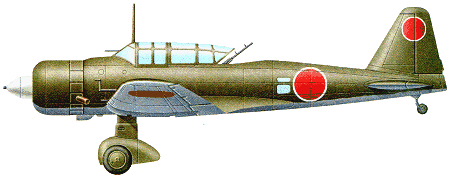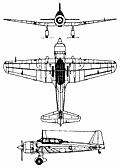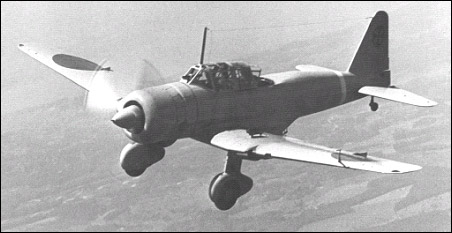|
| To meet an Imperial Japanese Army
specification of December 1937 for a
ground-attack aircraft, which it was
suggested could be a development of
the Ki-30 light bomber, Mitsubishi produced
two prototypes under the designation
Mitsubishi Ki-51. Of similar
external appearance to the Ki-30, the
new design was generally of smaller
dimensions, had a revised and simplified
cockpit that put the two-man
crew more closely together and, because
the bomb bay was not required,
the monoplane wing was moved from a
mid- to low-wing configuration.
Powerplant chosen was the Mitsubishi
Ha-26-II radial engine,
Tested during the summer of 1939,
the two prototypes were followed by
11 service trials aircraft, these being
completed before the end of the year.
They differed from the prototypes by
incorporating a number of modifications,
but most important were the introduction
of fixed leading-edge slots
to improve slow-speed handling and
armour plate beneath the engine and
crew positions. In addition to the standard
production aircraft, there were
attempts to develop dedicated reconnaissance
versions, initially by the conversion
of one Ki-51 service trials aircraft
which had the rear cockpit redesigned
to accommodate reconnaissance
cameras. Test and evaluation of
this aircraft, redesignated Ki-51a,
brought a realization that the standard
Ki-51 could be modified to have provisions
for the installation of reconnaissance
cameras, and this change was
made on the production line. Subsequently,
three Ki-71 tactical reconnaisance
prototypes were developed
from the Ki-51, introducing the 1119kW Mitsubishi Ha-112-11 engine,
retractable landing gear, two
wing-mounted 20mm cannon and
other refinements, but no production
examples were built.
Allocated the Allied codename
'Sonia', the Ki-51 was used initially in
operations against China, and was deployed
against the Allies until the end
of the Pacific war. In more intensely
contested areas the fairly slow Ki-51s
were easy prey for Allied fighters, but
in secondary theatres, where an ability
to operate from rough and short fields
was valuable, these aircraft gave
essential close support in countless operations.
In the closing stages of the
war they were used in kamikaze
attacks.

| MODEL | Ki-51 |
| CREW | 2 |
| ENGINE | 1 x Army Type 99 Mod. 2, 705kW |
| WEIGHTS |
| Take-off weight | 2798-2920 kg | 6169 - 6438 lb |
| Empty weight | 1873 kg | 4129 lb |
| DIMENSIONS |
| Wingspan | 12.1 m | 40 ft 8 in |
| Length | 9.21 m | 30 ft 3 in |
| Height | 2.73 m | 9 ft 11 in |
| Wing area | 24.02 m2 | 258.55 sq ft |
| PERFORMANCE |
| Max. speed | 424 km/h | 263 mph |
| Ceiling | 8270 m | 27150 ft |
| Range | 1060 km | 659 miles |
| ARMAMENT | 3 x 7.7mm machine-guns, 200-300kg of bombs |
 | A three-view drawing (752 x 1055) |
| lxbfYeaa, e-mail, 14.03.2024 06:27 20 reply | | sven, 22.09.2015 01:38 The Hucks starter can be seen in action at The Shuttleworth coillection UK. It was first used in the 14 18 war. When you see the size of some of the props of that era you understand why. Hand swings were often done by 2 or 3 men. 1 to pull the prop and the others to pull the guy out of the way. reply | | Klaatu83, e-mail, 21.09.2015 08:49 It was known as a "Hucks Starter" and was used as a method of starting engines on many aircraft during the 1930s and early 1940s. One might think of it as an updated version of the WW-I style engine starting method of swinging the propeller by hand, only updated with mechanical assist provided by power-take-off mounted on a specially-equipped motor vehicle. The advantage of a Hucks Starter was that the aircraft did not have to carry the additional weight of it's own engine starting system.
Phil Kuoni, Maj, USArmy (retir, 01.09.2013
That "thingie" is the connector for a starter shaft inserted from a rig mounted on a truck connected to the truck's motor.. That was the means of starting the motor as compared to explosive cartridges, external starter crank or an external ground starter unit ("putt putt"). The Russians also used this method of starting many of their aircraft. Hope this explains it for you. Phil
Ron Weil, 19.05.2013
Does anyone know what the "thingie" that looks like a cannon protruding from the prop spinner is? reply | | Patrick, e-mail, 13.04.2014 06:33 with the starter-spinner dog shaft truck thingie, many Japanese planes featured that starter set-up, and I got to inspect one close up on the engine crash remains of a Ki46 Dinah they have at the Tindal Darwin air museum in Australia..the weight-saving on not having an electric start and sometimes internal batteries is considerable, especially for aircraft relying on height and speed for defence like the Dinah. reply | |
| | Patrick, e-mail, 13.04.2014 06:28 I'm reading a book non-fiction, about the Japanese WW2 Kamikazes called "Blossoms in the Wind"...(can recommend the hell out of it, too, if you want a highly narrative of memoirs from surviving Japanese Ww2 "Tokko"pilots from a US author with high creds in Japanese language and culture)in it author describes in great detail an --IJA--Army(most Tokko were Navy) "Tokko" unit which was formed at Bacloban on Luzon, and equiped with Ki51s..I realised I'd never consciously heard of a Ki51, and thought he'd confused it with Ki15s, but when I saw the poor quality b /w pic of one of the units planes landing in the book, I realised it was no Ki15 Babs..I'd heard of the Ki30, and thought IT was the code-name 'Sonya"...but Ki30 is the "Ann" and Ki51 which looks almost the same but is a little smaller is the "Sonya"..now I have been into Ww2 planes since as a child in the 1960s, and Japanese ones were a special favorite with me, but that subtle distinction Ki30 vs Ki51, had slipped past me.
Anyway, after various mishaps in weather and mechanical issues he finally takes off in a Ki51 with bad performing smoking engine and dirty 'Marianas Gas" gasoline, and when within distant sight of a US troop convoy, is jumped by an F6F and forced down. reply | | Phil Kuoni, Maj, USArmy (retir, e-mail, 01.09.2013 06:30 That "thingie" is the connector for a starter shaft inserted from a rig mounted on a truck connected to the truck's motor.. That was the means of starting the motor as compared to explosive cartridges, external starter crank or an external ground starter unit ("putt putt"). The Russians also used this method of starting many of their aircraft. Hope this explains it for you. Phil reply | | Ron Weil, e-mail, 19.05.2013 19:54 Does anyone know what the "thingie" that looks like a cannon protruding from the prop spinner is? reply | | y.k, 13.12.2011 13:15 No.
It based on ki30,and ki30 based on ki15.
and ki15 based on A5M.
All of these have same structure and handling property. reply | | Andy, 13.12.2011 03:13 Was this based at all on the JU. 87? reply | | Ta-183, 16.05.2010 16:08 And it was used for kamikaze roles too. reply | | ta-183 Huckebein, 16.05.2010 16:07 Im making a short movie today I think i might put that plane in it because it looks cool. (The Movie is a about a renegade japanese pilot that attacks a formation of Australian Bombers) reply | | beruk, e-mail, 01.09.2010 12:01 You Can Find the only Survivor of this Aircraft in Adisucipto Aviation Museum, Jogjakarta, Indonesia reply | | Frank, e-mail, 23.10.2009 20:02 Could you post horsepower figures (hp) as well as kW for the engine ratings?
Thanks reply | | Sgt.KAR98, 03.01.2009 17:15 Looks a very nice plane. reply | |
| | Freeman, e-mail, 29.02.2008 14:51 Ki-51 wasn't a torpedo-bomber aircraft. It was only light bomber. Sometimes, this planes were used in recon role. reply | | John Doe, e-mail, 11.10.2007 19:00 Is it a Torpeto bombmer? reply | | Al Kretz, e-mail, 21.04.2007 01:47 I build, fly and compete in Radio Control Scale models. How can I obtain more information on the Mitsubishi KI-51 "Sonia"? I need 3-views, pictures and color schemes. Thanks reply |
|
Do you have any comments?
|
| 
COMPANY
PROFILE
All the World's Rotorcraft
|








